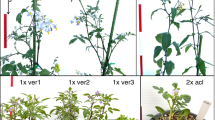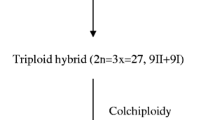Abstract
Field isolates and laboratory strains of Botrytis cinerea, an ascomycetous fungus causing considerable economic losses, e.g., as “grey mould” of vine, were compared for differences in ploidy level by determining their DNA content per nucleus. Strain SAS56, an ascospore line used routinely for genetic analyses, is probably polyploid, since treatment with benomyl causes a significant reduction in DNA content per nucleus. This conclusion is substantiated by the increased sensitivity of the putative haploid derivatives to mutagens (UV and EMS). Molecular analyses (RAPD) of the haploidized strains indicate a very limited degree of heterozygosis of the parent strain SAS56. Analysis of field isolates of B. cinerea showed that their DNA content per nucleus varied considerably, indicating that aneuploidy/polyploidy is a widespread phenomenon in this species. This can explain both the variability and phenotypic instability of many field isolates of this fungus and the unusual difficulties faced by researchers in recovering stable recessive laboratory mutants. Since the haploid derivatives of SAS56 resemble the parent strain in their parasitic and physiological properties they should provide a good basis for classical and molecular genetic studies.
Similar content being viewed by others
References
Anson ML (1938) J Gen Physiol 22:79–89
Bresinsky A, Fischer M, Meixner B, Paulus W (1987) Mycologia 79:234–245
Coley-Smith JR, Verhoef K, Jarvis WR (1980) The biology of Botrytis. Academic Press, London
Doyle JJ, Doyle JL (1990) Focus 12:13–15
Faretra F, Antonacci E (1987) Phytopathol Medit 26:29–35
Faretry F, Grindle M (1993) In: Verhoef K (ed) Recent advances in Botrytis research. Pudoc Scientific Publishers, Wageningen, pp 7–19
Faretra F, Pollastro S (1991) Mycol Res 95:943–951
Faretra F, Antonacci E, Pollastro S (1988a) Ann Microbiol 38:29–40
Faretra F, Antonacci E, Pollastro S (1988b) J Gen Microbiol 134: 2543–2550
Grindle M (1979) J Gen Microbiol 111:109 ff
Hastie JC (1970) Nature 226:771–772
Kombrink E, Schröder M, Hahlbrock K (1988) Proc Natl Acad Sci USA 88:782–786
Lauber HP (1971) Z Schweiz landwirtschaft Forsch 10:1–64
Leonowicz A, Grzowonowicz K (1981) Enzyme microbiology and technology 3:55–58
Lorenz DH, Eichhorn KW (1983) Z Pflanzenkr Pflanzensch 90:1–11
Phillips DJ, Margosan DA (1987) Phytopathology 77:1606–1608
Richmond DV, Phillips A (1975) Pest Biochem Physiol 5:367–379
Sambrock J, Fritsch EF, Maniatis T (1989) Molecular cloning: a laboratory manual. Cold Spring Harbor Laboratory, Cold Spring Harbor, New York
Shirane N, Masuko M, Hayashi Y (1989) Phytopathology 79: 728–773
Stein U (1985) Angew Bot 59:1–9
Tooley PW, Therrien CD (1992) In: Lucas JA, Shaltock RC, Shaw DS, Cooke LR (eds) Phytophthora. Cambridge University Press, Cambridge, pp 204–217
Van der Vlugt-Bergmans CJB, Brandwagt BF, Van't Klooster JW, Wagemakers CAM, Van Kan JAL (1993) Mycol Res 97:1193–1200
Weber E (1992) Biblio Mycol 140
Wittmann-Meixner B (1989) Biblio Mycol 139
Author information
Authors and Affiliations
Additional information
Communicated by K. Esser
Rights and permissions
About this article
Cite this article
Büttner, P., Koch, F., Voigt, K. et al. Variations in ploidy among isolates of Botrytis cinerea: implications for genetic and molecular analyses. Curr Genet 25, 445–450 (1994). https://doi.org/10.1007/BF00351784
Received:
Accepted:
Issue Date:
DOI: https://doi.org/10.1007/BF00351784




